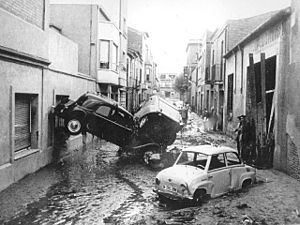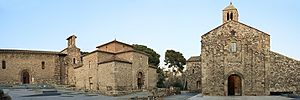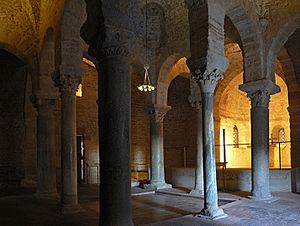Terrassa facts for kids
Quick facts for kids
Terrassa
|
|||
|---|---|---|---|
|
Municipality
|
|||
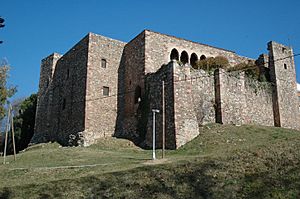
Castle of Vallparadís
|
|||
|
|||

Location in Vallès Occidental county
|
|||
| Sovereign state | |||
| Community | |||
| Region | Barcelona | ||
| County | Vallès Occidental | ||
| Province | Barcelona | ||
| Area | |||
| • Total | 70.2 km2 (27.1 sq mi) | ||
| Elevation | 286 m (938 ft) | ||
| Population
(2018)
|
|||
| • Total | 218,535 | ||
| • Density | 3,113.0/km2 (8,063/sq mi) | ||
| Demonym(s) | terrassenc, -ca egarenc, -ca (Catalan) |
||
| Time zone | UTC+1 (CET) | ||
| • Summer (DST) | UTC+2 (CEST) | ||
| Postcode |
08221 to 08229
|
||
| Official language(s) | Catalan and Spanish | ||
| Climate | Cfa | ||
Terrassa is a city in central-eastern Catalonia, Spain. It is located in the province of Barcelona. Terrassa is one of the two main cities of the Vallès Occidental county, sharing this role with Sabadell.
The name Terrassa comes from the Latin word Terracia. This might mean "earthen castle" or "area of flat land."
The city was once a Roman town called Egara. Later, it became an important religious center. Since 2004, Terrassa has been the seat of a bishopric, which is a church district led by a bishop.
Terrassa is in a low area called the Catalan Prelitoral depression. It sits at the foot of the Prelitoral mountain range, near the Sant Llorenç del Munt i l'Obac natural reserve. The city's average height is 277 meters (about 909 feet) above sea level. It is about 20 kilometers (12 miles) from Barcelona and 18 kilometers (11 miles) from Montserrat.
In 2020, Terrassa was the third largest city in Catalonia, after Barcelona and l'Hospitalet de Llobregat.
Contents
Terrassa's History
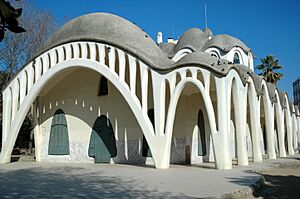
Terrassa has been home to people for a very long time, even before recorded history. In 2005, during the building of a railway tunnel, an ancient site was found in Vallparadís Park. This site had stone tools and animal fossils that are between 800,000 and 1,000,000 years old. This makes it one of the oldest prehistoric sites in Europe!
The city started as a Roman town called Egara. It was founded around 69–79 CE, near an older Iberian town.
In the 17th century, Terrassa was involved in some historical events. In 1619, six women were accused and found guilty of witchcraft. Five of them were executed on October 27, 1619, near where a railway bridge is today.
Other important old buildings from the Middle Ages include the former cathedral and the castle of Vallparadís. The castle was a monastery for a while and is now a city museum. There's also the tower of the count-king's castle-palace.
Industrial Growth and Modernista Buildings
In the 1800s, Terrassa became very important during the Industrial Revolution. The city was known for making wool fabrics. Because of its growth, many beautiful Modernista buildings were built. Modernisme is a style of art and architecture, similar to Art Nouveau.
Some famous Modernista buildings in Terrassa are:
- The Masia Freixa (built in 1907)
- The Vapor Aymerich, Amat i Jover textile mill (1907), which is now the Museum of Science and Industry of Catalonia
- The Principal theater (1920)
- The city hall (1902)
- The Alegre de Sagrera house/museum (1911)
- The Industrial School (1904)
- The Gran Casino (1920)
- The Parc de Desinfecció (1920)
- The Independència market (1908)
Terrassa is part of the Art Nouveau Network. This is a European group that works to study, protect, and share information about Art Nouveau.
Terrassa: A City of Film
Terrassa is a well-known place for making movies in Europe. UNESCO has even named it a City of Film. The city has the biggest film studios in Catalonia and the Iberian Peninsula, called the Parc Audiovisual de Catalunya. Many movies and TV shows have been filmed here, such as REC, A Monster Calls, and Operación Triunfo.
Major Flood of 1962
On September 25, 1962, Terrassa experienced a very heavy rainfall after a long dry summer. Between 212 and 252 liters of rain fell per square meter in just three hours. This caused the Llobregat and Besòs rivers and their smaller streams to overflow. The rushing water caused a lot of damage and led to about 700 people losing their lives.
The Vallès Occidental area was hit the hardest, and Terrassa had 327 victims.
Religious History
The city of Ègara (now Terrassa) had a bishopric, a church area led by a bishop, as early as 450 CE. This bishopric was created from parts of the Diocese of Barcelona.
When the Arab (Muslim) conquest happened in the 8th century, the bishopric likely stopped existing. Its territory was then returned to the Diocese of Barcelona. The main church, Santa Maria, was taken over in 718 but was rebuilt in the 12th century. Today, it is part of a group of old Visigothic and Romanesque churches called Sant Pere de Terrassa and Sant Miquel.
After the Christian Reconquista of the region, the bishopric was not immediately brought back. However, in 2004, Pope John Paul II created a new Diocese of Terrassa. Its main church is the Cathedral of Holy Spirit.
Famous Places to See
The Churches of Sant Pere (Saint Peter)
These three churches were built near the old Roman town of Ègara. They were meant to be the center of the Ègara Diocese, which started around 450 CE. This group of churches includes two main churches (Sant Pere and Santa Maria) and a mausoleum (Sant Miquel). After a long time of building, the churches were finished in the 11th and 12th centuries in the Romanesque style. They were built on top of older buildings from the Visigothic period.
The church of Santa Maria has amazing artworks, including murals from the Romanesque and Gothic periods. There's also an altar stone from the 10th century and old tombstones. In the transept (the part of a cross-shaped church that crosses the main part), there are three Gothic altarpieces.
- Santa Maria (Saint Mary) - the old Cathedral
* The Apse (rounded end of the church) is from the 6th century. * The Nave (main part of the church) is from the 11th century with decorations in the Lombardy style. * It has Romanesque frescoes (wall paintings) of Saint Thomas Becket from the 12th century. * There are also frescoes from the 13th century.
- Sant Pere (Saint Peter)
* The transept and apse are from the 9th to 10th centuries. * The nave is from the 12th century. * It features a Mosaic from the 10th century with geometric designs. * There is a stone altarpiece of Sant Pere from the 10th century. * Gothic frescoes from the 13th century can be seen here.
- Sant Miquel (Saint Michael)
* Its Greek cross shape and walls are the original ones from the 6th century. * Frescoes from the 7th and 8th centuries are in the apse.
- Other Artworks
* Altarpiece of Sant Pere (1411) by Lluís Borrassà * Altarpiece of Roser (1587) * Altarpiece of Sant Ruf (17th century) * Altarpiece of Sant Miquel (1450–51) by Jaume Cirera and Guillem Talarn * Gothic altarpiece of Sant Abdó i Sant Senén (1460) by Jaume Huguet * A colorful sculpture of Saint Mary from the 14th century
Other Notable Places
Terrassa has a rich history, with many medieval, Modernista, and industrial buildings. It also has many libraries, historical archives, and museums.
- The Museum of Terrassa has several parts:
* The Castle/Charterhouse of Vallparadís, located in the Park of Vallparadís. * The Visigothic-Romanesque churches of Sant Pere (Saint Peter). * Casa Alegre de Sagrera, a Modernista house. * The Tower of the Palau, which is the only remaining part of the castle-palace of the count-kings of Catalonia in Terrassa. * The Center of medieval interpretation of the city of Terrassa. * The Convent of Sant Francesc, which has a cloister (a covered walkway) decorated with colorful ceramics from 1671–1673.
- The Museum of Science and Industry of Catalonia is in the old Aymerich Amat i Jover mill.
Getting Around Terrassa
Terrassa is well connected to Barcelona's port and airport by highways and railways. The C-58 and C-16 highways also link the city to other places like Manresa, Girona, France, and Tarragona.
The railway first came to Terrassa in 1856. Today, two train lines serve the city. One is run by Renfe and connects to Barcelona and Lleida. The other is run by FGC and connects to Barcelona. Recently, FGC extended its line with three new stations in the north of the city. This extension is known as the Terrassa Metro.
Many interurban bus lines connect Terrassa with nearby cities and towns. These include Sabadell, Castellar del Vallès, Martorell, Rubí, Sant Cugat del Vallès, and Vacarisses.
Inside the city, there are 14 bus lines run by a city company called Transports Municipals d'Ègara. In the future, with more train stations, the railway will also help people travel within the city.
Terrassa's Culture
Music and Theater
Terrassa is home to many musicians and actors. This is because it has many music schools, a long history of amateur theater, and a university for drama. Since 1982, the Terrassa Jazz Festival has been very popular, featuring famous musicians like Stan Getz, Chet Baker, and Dete Montoliu. Local bands like Doctor Prats have also become well-known.
News and Media
Terrassa has its own local newspaper, the Diari de Terrassa, published from Tuesday to Saturday. There are also several radio stations:
- Ràdio Terrassa/Cadena SER Vallès (828 AM and 89.4 FM) is one of the oldest radio stations in Catalonia and Spain.
- The city's own radio, Noucincpuntdos (95.2 FM).
- Radio Star de Terrassa (100.5 FM), a cultural station founded in 1984.
The city also has local TV channels like TV20 Locàlia Vallès and Canal Terrassa. These channels reach over 50,000 viewers. There are also free newspapers like Terrassa Societat and Terrassa Month. The city's official website, www.terrassa.cat, gets more than 150,000 visitors each month.
Sports in Terrassa
Terrassa was one of the first cities in Catalonia to play field hockey and korfball. It also helped introduce basketball. The most popular sport in the city is field hockey. During the Barcelona Olympic Games in 1992, Terrassa hosted the field hockey competition.
Many field hockey players from Terrassa have competed in the Olympic Games. Because of this, Terrassa is sometimes called the "most Olympic city in the world." Between 1928 and 2004, 124 athletes from Terrassa went to the Olympics, mostly hockey players. Three local field hockey clubs—Atlètic Terrassa, Club Egara, and Club Deportiu Terrassa—have all won national championships. Atlètic Terrassa and Club Egara have also won European championships.
Other local sports teams include:
- Club de Rugby Carboners de Terrassa (rugby)
- CN Terrassa (water polo)
- Terrassa FC (soccer)
- CP San Cristóbal (soccer)
- Sferic Terrassa (basketball)
Terrassa is also the hometown of famous soccer players Xavi and Dani Olmo, who play for FC Barcelona and the Spanish national team.
The city has two castells teams, which are groups that build human towers: the Minyons de Terrassa and the Castellers de Terrassa. On November 22, 2015, the Minyons team made history in Terrassa's Plaça Vella by completing the world's first successful 4 de 10 amb folre i manilles, a very tall and complex human tower.
Sister Cities
Terrassa is connected with five cities around the world:
Terrassa also has a special cooperation agreement with:
- Otavalo, Ecuador
Famous People from Terrassa
- Nebridius (5th c. – 6th c.), religious figure
- Joseph Oller (1835-1922), businessman
- Domingo Cirici Ventalló (1878-1917), writer
- Cristina Lacasa (1929-2011), writer
- Joana Biarnés (1935-2018), photographer
- Jaime Comas (1936-2021), screenwriter and producer
- Marta Pessarrodona (born 1941), writer
- Francesc Abad (born 1944), artist
- Eulàlia Grau (born 1946), artist
- Jordi Camí (born 1952), pharmacology expert
- Josep Roig Boada (born 1957), composer and producer
- Assumpta Escarp i Gibert (born 1957), politician
- Concha García Campoy (1958-2013), journalist
- Sergi Belbel (born 1963), playwright
- Josep Guijarro (born 1957), journalist and writer
- Pere Navarro (born 1959), politician
- Lluís Puig (born 1959), art director
- Enric Millo (born 1960), politician
- Josep Rull (born 1968), politician
- DJ Skudero (born 1976), music producer
- Aleix Villatoro i Oliver (born 1979), politician
- Xavi (born 1980), soccer player and manager
- Jordi Ballart (born 1980), politician and mayor
- Cristian Canton Ferrer (born 1980), writer, musicologist and pianist
- Aleix Alcaraz (born 1990), racing driver
- Miki Núñez (born 1996), singer
- Dani Olmo (born 1998), soccer player
Images for kids
See also
 In Spanish: Tarrasa para niños
In Spanish: Tarrasa para niños






